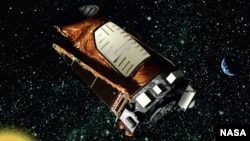NASA says its Kepler space telescope, which has been leading the search for Earth-like planets throughout the universe, has been crippled by the failure of one of the mechanical reaction wheels that helps keep it pointed.
The U.S space agency announced Wednesday that unless the reaction wheel's operation can be restored, or another way found to orient the spacecraft, Kepler's planet-hunting efforts will have come to a premature end.
Kepler was launched in 2009 on a seven-year mission to determine how many stars beyond our solar system are likely to host Earth-like planets in habitable orbits. The space telescope has been carrying out a survey of hundreds of thousands of stars in one region of space looking for tell-tale blinks in starlight that signal the transit of an orbiting planet. So far, Kepler has identified 132 exoplanets and spotted 2,740 candidates.
NASA officials say they will continue trying to fix the faulty spacecraft, and will not give up on Kepler until the space telescope can no longer perform useful science.
Kepler was launched with four reaction wheels, and needs at least three of the critical positioning devices to keep its telescopic instruments precisely aimed at distant stars. One failed last year, and the wheel that failed Wednesday began showing signs of abnormal friction several months ago.
NASA engineers tried shutting down the space telescope for two weeks, in the hope that lubricants might redistribute on the wheel and solve the problem. But the friction was still there when they resumed operations. Until now, the problem had not interfered with telescope operations.
The U.S space agency announced Wednesday that unless the reaction wheel's operation can be restored, or another way found to orient the spacecraft, Kepler's planet-hunting efforts will have come to a premature end.
Kepler was launched in 2009 on a seven-year mission to determine how many stars beyond our solar system are likely to host Earth-like planets in habitable orbits. The space telescope has been carrying out a survey of hundreds of thousands of stars in one region of space looking for tell-tale blinks in starlight that signal the transit of an orbiting planet. So far, Kepler has identified 132 exoplanets and spotted 2,740 candidates.
NASA officials say they will continue trying to fix the faulty spacecraft, and will not give up on Kepler until the space telescope can no longer perform useful science.
Kepler was launched with four reaction wheels, and needs at least three of the critical positioning devices to keep its telescopic instruments precisely aimed at distant stars. One failed last year, and the wheel that failed Wednesday began showing signs of abnormal friction several months ago.
NASA engineers tried shutting down the space telescope for two weeks, in the hope that lubricants might redistribute on the wheel and solve the problem. But the friction was still there when they resumed operations. Until now, the problem had not interfered with telescope operations.






